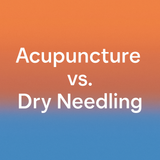Acupuncture vs. Dry Needling: What’s the Difference?
At first glance, acupuncture and dry needling might seem identical. Both involve inserting thin needles into the skin, and both are used to treat pain. However, these two techniques are fundamentally different in their philosophy, application, training requirements, and treatment goals.
In this post, we’ll break down the key differences between acupuncture and dry needling so you can better understand which therapy might be right for you—or for your patients if you’re a practitioner.
What Is Acupuncture?
Acupuncture is a technique rooted in Traditional Chinese Medicine (TCM), practiced for thousands of years. It involves inserting fine needles into specific points on the body called acupoints, which are thought to lie along pathways called meridians. According to TCM, these meridians carry Qi (vital energy), and acupuncture aims to restore balance to this energy flow to promote healing and overall wellness.
Acupuncture is used to treat a wide range of conditions, including:
-
Chronic pain
-
Migraines
-
Anxiety and stress
-
Nausea
-
Digestive issues
-
Insomnia
-
Menstrual problems
What Is Dry Needling?
Dry needling is a modern, evidence-based technique rooted in Western medicine and musculoskeletal anatomy. It targets myofascial trigger points—tight, irritable knots within muscles that can cause pain and movement dysfunction. Unlike acupuncture, dry needling does not follow meridian theory or aim to balance Qi.
The goal is to relieve muscle tightness, reduce pain, and improve movement by stimulating these trigger points with a fine, solid needle. A twitch response (a quick muscle contraction) during the procedure is a common and often desired effect.
Dry needling is commonly used by:
-
Physical therapists
-
Chiropractors
-
Sports medicine practitioners
It’s especially effective for:
-
Neck and back pain
-
Muscle tightness and spasms
-
Sports injuries
-
Tendinopathies
-
Limited range of motion
Key Differences Between Acupuncture and Dry Needling
To make the comparison clearer, here’s a summary table outlining the main distinctions between the two techniques:
|
Feature |
Acupuncture |
Dry Needling |
|---|---|---|
|
Origin |
Traditional Chinese Medicine |
Western medicine / modern anatomy |
|
Main Focus |
Balancing Qi via meridians |
Releasing muscular trigger points |
|
Practitioners |
Licensed acupuncturists |
Physical therapists, chiropractors, and MDs |
|
Conditions Treated |
Broad: physical, emotional, systemic |
Primarily musculoskeletal pain and dysfunction |
|
Needle Technique |
Superficial, often left in longer |
Deep insertion often elicits a twitch response |
|
Treatment Goals |
Whole-body balance and wellness |
Local pain relief and functional restoration |
|
Regulation |
Strictly regulated worldwide |
Varies by location and practitioner type |
Similarities Between Acupuncture and Dry Needling
Despite their differences, acupuncture and dry needling share some similarities:
-
Both use very fine, solid filiform needles
-
Both can be effective for treating pain
-
Both require training and certification
-
Both are generally low-risk and well-tolerated when performed by qualified professionals
Which One Should You Choose?
The right choice depends on your symptoms, treatment goals, and the philosophy of care you prefer.
-
Choose acupuncture if you’re looking for a holistic, energy-based approach or want to address a range of physical and emotional symptoms.
-
Choose dry needling if you’re dealing with localized musculoskeletal pain, trigger points, or sports injuries, and prefer a Western, anatomy-focused method.
If you’re unsure, consult a healthcare provider familiar with both methods to guide you to the best option for your needs.
Final Thoughts on Acupuncture and Dry Needling
While acupuncture and dry needling may look similar on the surface, they differ in intent, technique, and application. Understanding the differences empowers you to make informed choices about your care—or your practice if you’re a healthcare provider. Whether you’re seeking pain relief or improved mobility, both approaches can offer effective solutions when used appropriately by trained professionals.
Recent Posts
-
Acupuncture vs. Dry Needling: What’s the Difference?
At first glance, acupuncture and dry needling might seem identical. Both involve inserting thin need …Jun 11th 2025 -
What Is Dry Needling? A Modern Approach to Pain Relief and Muscle Recovery
Chronic muscle pain, tension, and restricted movement can significantly impact your daily life, sign …Jun 11th 2025 -
The Kinetic Chain and Its Importance?
The kinetic chain is a key principle in physical therapy, referring to the way muscles, joints, and …Apr 18th 2025



